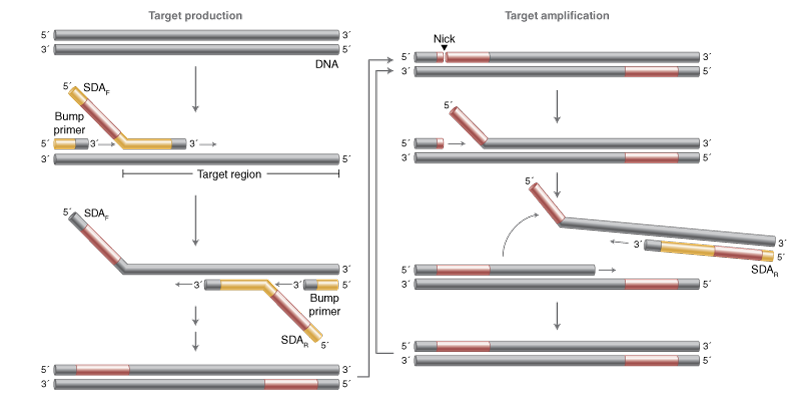
Isothermal Amplification & Strand Displacement
Molecular diagnostic applications require high levels of consistency and the ability to set up reactions at room temperature or in high throughput formats. To address these needs in the isothermal space, NEB has created reversible inhibitors for many of the enzymes used in these workflows. Whereas traditional hot start mechanisms (e.g., chemical modifications and antibodies) require high heat steps to reverse inhibition, aptamers selected to control isothermally-relevant enzymes (Bst 2.0 DNA Polymerase, WarmStart® RTx and Luna reverse transcriptases, etc.) dissociate from their targets at much lower temperatures, enabling their use in these rapid and lower temperature workflows. For more information on controlling enzyme activity with aptamers, refer to this article.
In additional to enzyme control, NEB has engineered new variants of Bst large fragment to increase reaction speed, thermostability, robustness and inhibitor tolerance, as well as enhanced reverse transcriptase activity for single-enzyme RNA/DNA detection approaches (Bst 2.0, Bst 3.0). WarmStart RTx can be combined with the new Bst polymerases for optimum RNA detection. Additionally, our unique Colorimetric LAMP Master Mix includes a color-changing visual indicator for simple, rapid identification of amplification that does not require sophisticated instrumentation. An updated version of this product has been formulated with dUTP and UDG to be compatible with carryover prevention between amplification rounds – WarmStart Colorimetric LAMP 2X Master Mix with UDG. This mix is a key component of the SARS-CoV-2 Rapid Colorimetric LAMP Assay Kit, which can be used in the analysis of SARS-CoV-2, the novel coronavirus that causes COVID-19.
To additionally support diagnostic needs, many of the isothermal products and enzymes are available without glycerol and at custom concentrations for lyophilization or specific platform needs. Contact our Customized Solutions team with any request for enzymes in a format different from what is listed on a product page.
Choose Type:
- One-Step qHDA (Real-time quantitative tHDA)
- One-Step qRT-HDA (Real-time quantitative RT-HDA)
- One-Step RT-HDA (Reverse Transcription tHDA)
- One-Step tHDA (thermostable HDA)
- Two-Step qHDA (Real-time quantitative tHDA)
- Two-Step qRT-HDA (Real-time quantitative RT-HDA)
- Two-Step RT-HDA (Reverse Transcription tHDA)
- Two-Step tHDA (thermostable HDA)
- A-Tailing with Klenow Fragment (3'→5' exo-)
- Typical LAMP Protocol (M0275)
- Typical LAMP Protocol (M0538)
- Typical LAMP Protocol (M0374)
- WarmStart Colorimetric LAMP 2X Master Mix Typical LAMP Protocol (M1800)
- WarmStart LAMP Kit (DNA & RNA) Protocol (E1700)
-
Anatomy of a Polymerase - How Function and Structure are Related
Read about the relationship between Polymerase structure and function when copying DNA.
-
Using aptamers to control enzyme activity: Hot Start Taq and beyond
This article describes the use of engineered oligonucleotides known as aptamers in regulating the enzyme activity of polymerases and reverse transcriptases.
-
Many Initiatives Turning to RT-LAMP as Alternative to PCR for Rapid COVID-19 Screening Assays
There is an increasing demand for large-scale screening and surveillance testing, teams are now scaling up rapid SARS-CoV-2 screening assays incorporating RT-LAMP.
-
BMG LABTECH: LAMP assay for detecting SARS-CoV-2 RNA using an absorbance-based colorimetric readout
There is an increasing demand for large-scale screening and surveillance testing, teams are now scaling up rapid SARS-CoV-2 screening assays incorporating RT-LAMP.
- Isothermal Amplification Brochure
Feature Articles
Brochures
- Zhang M, Ye J, He JS, et al. (2020) Visual detection for nucleic acid-based techniques as potential on-site detection methods. A review. Anal Chim Acta; 1099:1–15, PubMedID: 31986265, DOI: 10.1016/j.aca.2019.11.056
- Calvert AE, Biggerstaff BJ, Tanner NA, Lauterbach M, Lanciotti RS. (2017) Rapid colorimetric detection of Zika virus from serum and urine specimens by reverse transcription loop-mediated isothermal amplification (RT-LAMP) PLoS One; 12(9):e0185340, PubMedID: 28945787, DOI: 10.1371/journal.pone.0185340
- Schoepp NG, Schlappi TS, Curtis MS, et al. (2017) Rapid pathogen-specific phenotypic antibiotic susceptibility testing using digital LAMP quantification in clinical samples Sci Transl Med; 9(410):eaal3693, PubMedID: 28978750, DOI: 10.1126/scitranslmed.aal3693
- Tanner NA, Evans TC Jr. (2014) Loop-mediated isothermal amplification for detection of nucleic acids Curr Protoc Mol Biol; 105, PubMedID: 24510439
- Poole, C.B., Sinha, A., Ettwiller, L., Apone, L., McKay, K., Panchapakesa, V., Lima, N.F., Ferreira, M.U., Wanji, S., Carlow, C.K.S (2019) In silico identification of novel biomarkers and development of new rapid diagnostic tests for the filarial parasites Mansonella perstans and Mansonella ozzardi Sci Rep; 9 (1), 10275. PubMedID: 31311985, DOI: 10.1038/s41598-019-46550-9
- Nzelu CO, Kato H, Peters NC. (2019) Loop-mediated isothermal amplification (LAMP): An advanced molecular point-of-care technique for the detection of Leishmania infection PLoS Negl Trop Dis; 13(11):e0007698, PubMedID: 31697673, DOI: 10.1371/journal.pntd.0007698
- Toldrà A, O'Sullivan CK, Campàs M. (2019) Detecting Harmful Algal Blooms with Isothermal Molecular Strategies Trends Biotechnol; 37(12):1278–1281, PubMedID: 31399265, DOI: 10.1016/j.tibtech.2019.07.003
- Mao D , Chen T , Chen H , et al. (2019) pH-Based immunoassay: explosive generation of hydrogen ions through an immuno-triggered nucleic acid exponential amplification reaction Analyst; 144(13):4060–4065, PubMedID: 31165121, DOI: 10.1039/c9an00506d
Template/product specificity: Is RNA or DNA involved? Is the 3´ terminus at a gap, nick or at the end of the template?
Removal of existing nucleotides: Will the nucleotide(s) be removed from the existing polynucleotide chain as part of the protocol? If so, will they be removed from the 5´ or the 3´ end?
Thermal stability: Does the polymerase need to survive incubation at high temperature or is heat inactivation desirable?
Fidelity: Will subsequent sequence analysis or expression depend on the fidelity of the synthesized products?
Products and content are covered by one or more patents, trademarks and/or copyrights owned or controlled by New England Biolabs, Inc (NEB). The use of trademark symbols does not necessarily indicate that the name is trademarked in the country where it is being read; it indicates where the content was originally developed. The use of this product may require the buyer to obtain additional third-party intellectual property rights for certain applications. For more information, please email busdev@neb.com.
This product is intended for research purposes only. This product is not intended to be used for therapeutic or diagnostic purposes in humans or animals.








